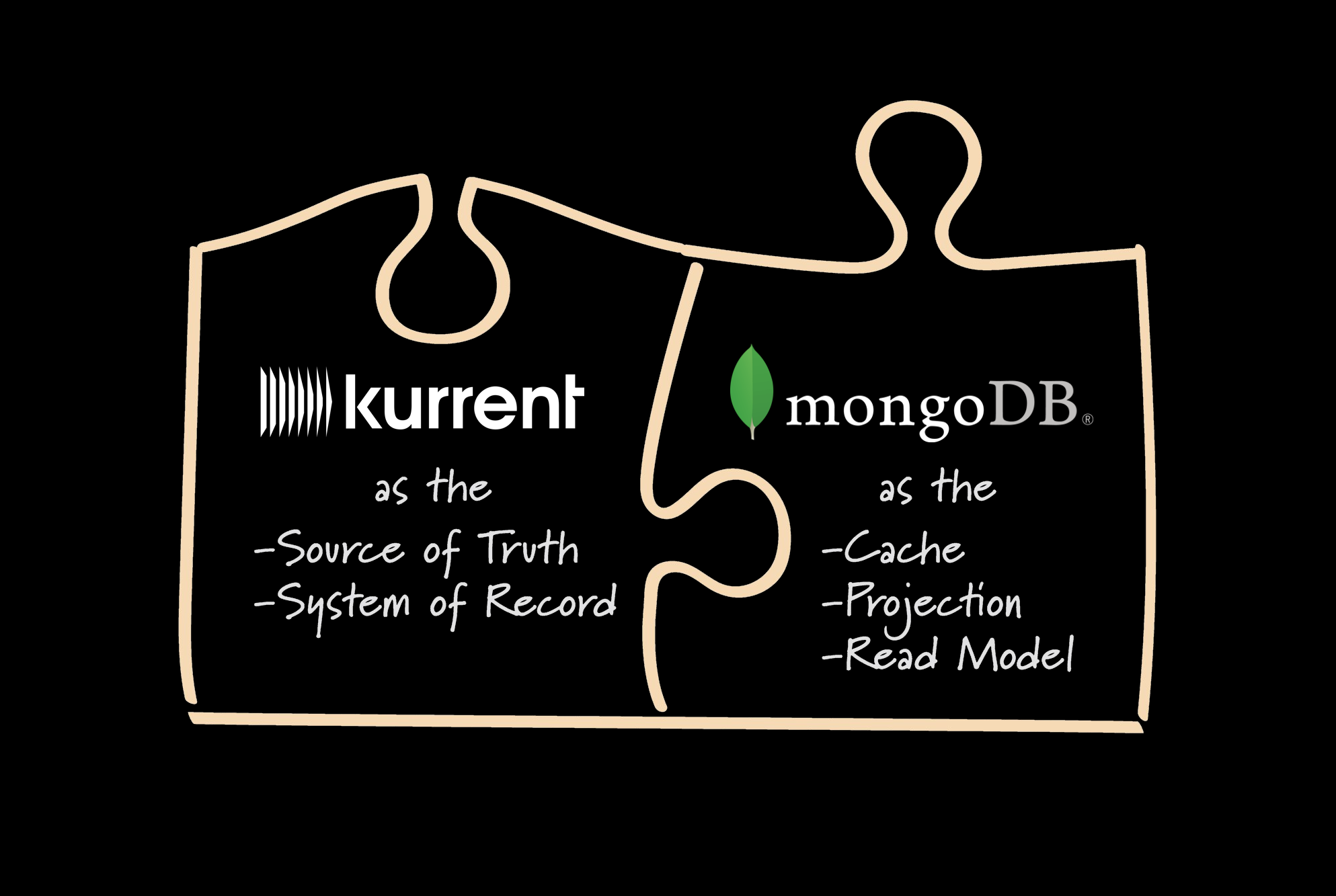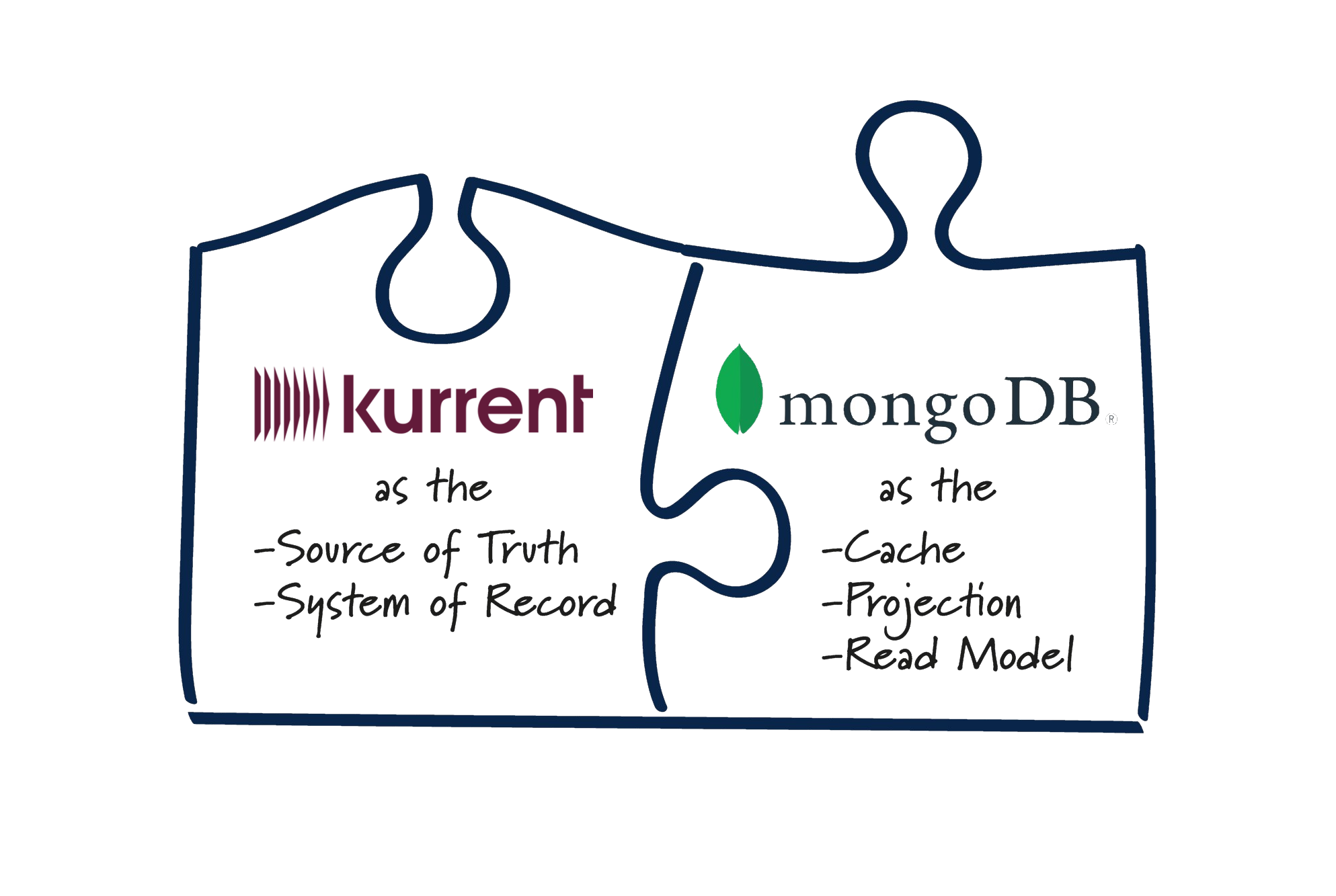How KurrentDB Complements MongoDB

Introduction
There are many new types of databases available today, and KurrentDB as an event-native database is one of them. In contrast, MongoDB has been around for a while and is a popular document database.
What is the relationship between KurrentDB and MongoDB? What are their respective strengths? And do they work well together?
Keep reading to find out more!
What is KurrentDB?
KurrentDB is a database built for event sourcing. It is an event-native database that stores historical events of facts that occurred in an application as an event log. Unlike traditional databases, which usually only store the current state and overwrite past data, KurrentDB retains the past data.
An event-native database consists of two major components:
- Events are state transitions that represent an important business decision in your application (e.g.
OrderPlaced,OrderPaid,OrderDelivered). Because they capture business actions taken, they are more granular and fundamental than state changes that are based on database operations. (e.g.OrderInserted,OrderUpdated,OrderDeleted) - The Log is an append-only log that captures all events that occur in your application. Each appended event is assigned a sequential number. This is a global sequence number in the log which is incremented whenever a new event is appended. This allows the log to record the exact order in which the events arrive at the database.
Strengths of KurrentDB
| Strength | Explanation |
|---|---|
| Expose Reason Behind each Decision | Millions of decisions are made in an organization each year. KurrentDB retains these decisions as events in named sequences/streams, which can expose key reasons of success and failures. |
| Time Travel to the Past, Present, and Future | Storing the history of events allows KurrentDB to reconstruct the past and present. Additionally, with a sufficient number of events, the future can be forecasted using machine learning. |
| Great Support for Eventual Consistency | KurrentDB provides excellent support for eventual consistent operations in downstream systems. This simplifies issues such as dual writes, message loss, duplication, and ordering. |
| Decouple Complex and Monolithic Systems | KurrentDB provides the freedom to reconstruct events into any schema, database model, or infrastructure, making it easy to decouple business functions from a specific system. |
| Guide Developers to Better System Design | KurrentDB aligns perfectly with practices such as Event Storming and Event Sourcing. These practices enable developers to design processes and application code that are more closely aligned to the business. |
Where KurrentDB Shines
KurrentDB shines as the source of truth of core business data, particularly in complex systems that frequently change and have myriads of business constraints.
What is MongoDB?
MongoDB is a document database that focuses on flexibility and scalability in data management. Unlike relational databases, MongoDB stores data in schema-less and JSON-like documents, allowing for more intuitive representation and querying of complex data structures.
As a document database, MongoDB comprises two major components:
- Documents: These are the core units of data in MongoDB. Each document is a set of key-value pairs, similar to JSON objects. Documents can contain nested documents and arrays, allowing for the representation of complex hierarchical data structures. This contrasts with the flat, table-like structure of relational databases. Typical operations on documents include
Insert,Update,Delete, andFind, which align with the Create, Read, Update, and Delete (CRUD) operations in database management. - Collections: MongoDB stores documents in collections, which are comparable to tables in relational databases. However, unlike tables, collections do not enforce a strict schema. This means that documents within the same collection can have different fields. Collections also support various indexing options to optimize query performance. MongoDB also supports advanced features like aggregation for data analysis, replication for data availability and redundancy, and sharding for horizontal scalability.
Strengths of MongoDB
| Strength | Explanation |
|---|---|
| Flexibility of Documents | Documents in MongoDB are schema-less, which makes it easy to update to any structure during development and for future changes. |
| Developer Friendly JSON Data Model | Documents in MongoDB are structured in JSON, making them easy to process with modern languages like JavaScript. This reduces the need for developers to switch context between the application model and the database model. |
| Great Support for Horizontal Scalability | MongoDB supports various scaling techniques, such as replication and sharding, which allow it to serve data to a large number of audiences. |
| Rich Set of Query Operators | MongoDB supports a wide range of document query operations such as filtering, sorting, aggregation that makes it easy to perform data analytics. |
Where MongoDB Shines
MongoDB shines as a widely distributed storage for data with a simple model that doesn’t have complex transactional requirements but requires high scalability.
KurrentDB and MongoDB Complements Each Other


KurrentDB complements MongoDB
KurrentDB and MongoDB work extremely well together in practice, where their benefits complement each other.
KurrentDB is typically used as the source of truth or the system of record. It acts as an authoritative source where data is stored and serves as the only location for updates. Because:
- It records data at a more granular level (via events) and retains it over time, allowing it to store data at a higher definition than any other type of database.
- Its auditability facilitates the distribution of data to downstream systems in an eventually consistent manner.
MongoDB, on the other hand, is perfect as the cache or what we call the read model. A downstream read-only view or projection of the source of truth. Because:
- It has a superb capability to horizontally scale reads, making it suitable for distributing data to a large audience.
- Its data structure is flexible, developer-friendly, and offers a wide range of querying functions, making it an ideal cache optimized for quick retrieval.
For example, KurrentDB is suitable for storing credit card transactions, while MongoDB would be perfect for storing account summary JSON tailored to a particular user web page.
How to integrate KurrentDB & MongoDB


How KurrentDB works with MongoDB
At a high level, an application change is saved as an event in KurrentDB. The event is then published to a custom projector service, which subscribes to new events and updates the MongoDB replica set.
Here is the process description in detail:
- The requestor (a user) sends an API request to update the application (e.g., withdraw from an account)
- The API receives the request and makes sure the change satisfies all business constraints (e.g., balance below credit limit)
- The API generates an event and appends it to KurrentDB’s event log (e.g., withdrew from account event)
- The projector, responsible for updating MongoDB, receives the event from KurrentDB using a catch-up subscription
- The projector composes an update operation for MongoDB using the event data and executes it (e.g., updates the account summary document)
- MongoDB’s primary node updates the document on itself
- MongoDB’s secondary node replicates the update from the primary node
- Many end users queries results from the MongoDB replica set
Closing
KurrentDB and MongoDB work well together when KurrentDB serves as the source of truth and MongoDB is used for projections or as a read model.
This maximizes the fidelity of the data stored in the source of truth, whilst enabling the distribution of that data to optimized forms to a large number of audiences.
